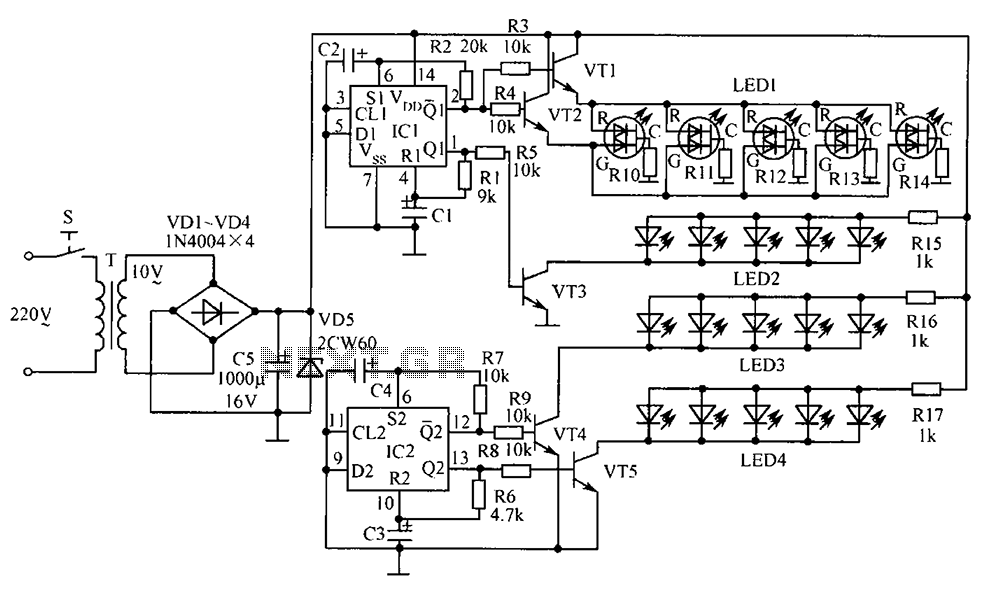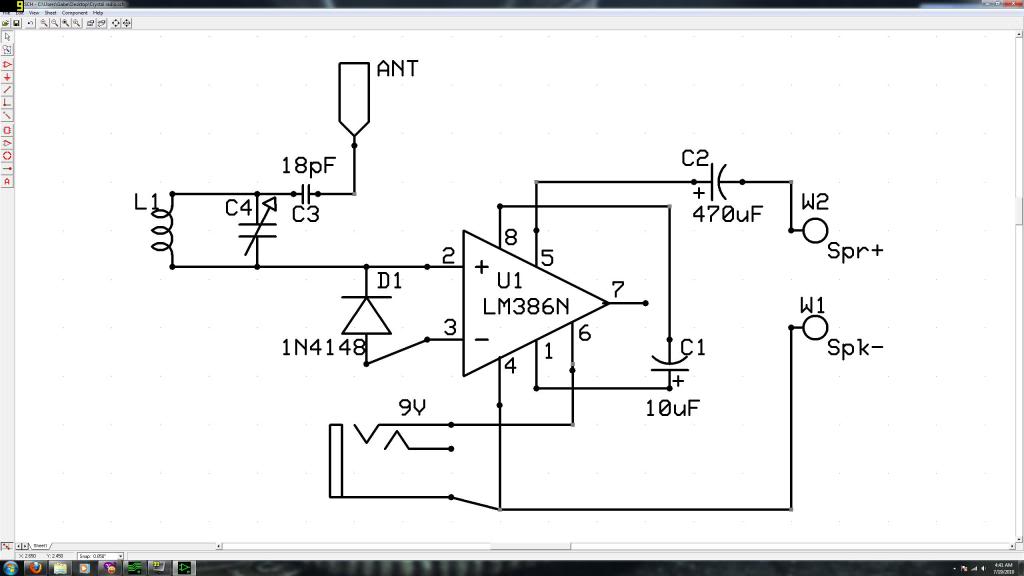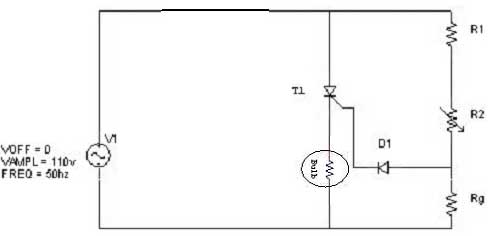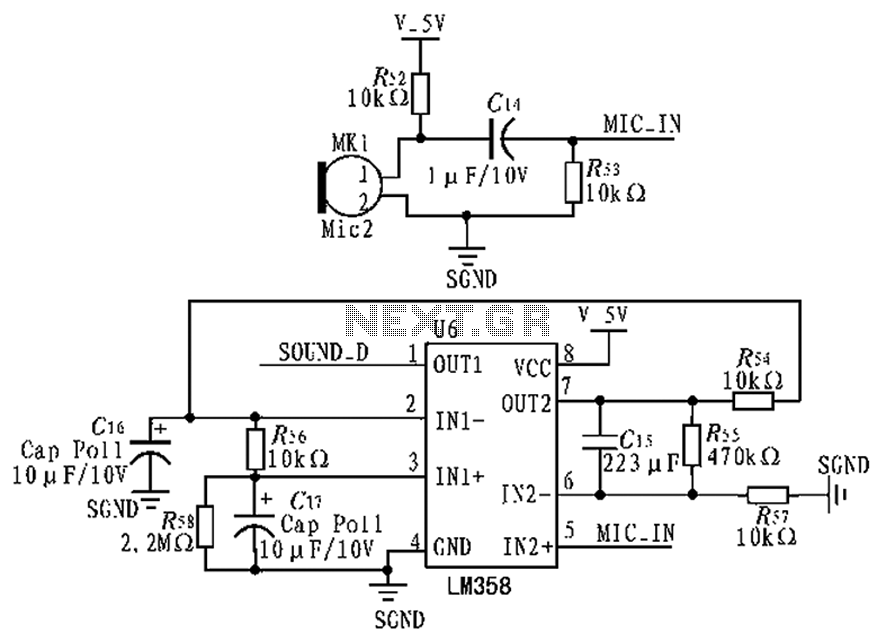
Bonsai electronic circuit

The electronic components designed by conventional electronic bonsai create a sparkling and brilliant atmosphere in the living room, enhancing the joys and pleasures of life. The selection of components includes IC1 to IC4, which consist of two pairs of D flip-flops (CD4013). All transistors used are selected VT 9013 NPN silicon transistors with a beta rating of 90. The LED models are chosen informally to achieve a flashing effect, where even a group of five LEDs may not share the same color. If the number of LEDs is insufficient, it is possible to increase the quantity; however, larger transistors such as 8050 or DD01 will be necessary. Resistors R10 to R14 are selected at 470 ohms, while capacitors C1 to C8 are 1000 µF/16V electrolytic capacitors. A small touch-type power switch (CS-316) is utilized, and a small power transformer rated at 220V/10V, 5W is employed.
The circuit described utilizes two pairs of D flip-flops (CD4013), which serve as the primary control elements for the LED flashing effect. The D flip-flops are configured to toggle states based on clock inputs, creating a sequential output that drives the LEDs. The choice of VT 9013 transistors ensures that the circuit can handle the required current for the LEDs while maintaining a suitable switching speed due to their beta rating of 90.
The LEDs, while selected for their visual impact, can vary in color, contributing to a dynamic display. In cases where a higher brightness or more extensive LED array is desired, the use of larger transistors like the 8050 or DD01 is recommended to accommodate the increased current demands. The resistors (R10 to R14) at 470 ohms provide current limiting for the LEDs, ensuring that they operate within safe limits and prolong their lifespan.
Capacitors C1 to C8, rated at 1000 µF/16V, are employed to smooth out any voltage fluctuations in the circuit, providing stability to the operation of the flip-flops and preventing flickering of the LEDs. The touch-type power switch (CS-316) allows for easy activation and deactivation of the circuit, enhancing user convenience.
Lastly, the transformer rated at 220V/10V, 5W is responsible for stepping down the mains voltage to a suitable level for the circuit, ensuring safe operation. This design not only serves a functional purpose but also adds aesthetic value to the living space, making it an ideal choice for decorative lighting applications. As shown for the electronic components made by conventional electronic bonsai, on the living room, sparkle, brilliance make houseful, joys and pleasures of life. Components Sel ection: IC1 ~ IC4 are two pairs of D flip-flop CD4013; all the transistors are selected VT 9013 and other NPN silicon transistor, beta 90. LED models informal, in pursuit of flash effect, even if the same group of five LED is not necessarily a color.
As the number of too little LED, can be increased, but slightly larger transistors are required to use, such as 8050, DD01 and the like. R10 ~ R14 choose 470 Omega resistance. C1 ~ C8 selection 1001 mu F/16V electrolytic capacitor. S for small touch-type power switch CS-316. T use 220V/10V, 5W of small power transformers.
The circuit described utilizes two pairs of D flip-flops (CD4013), which serve as the primary control elements for the LED flashing effect. The D flip-flops are configured to toggle states based on clock inputs, creating a sequential output that drives the LEDs. The choice of VT 9013 transistors ensures that the circuit can handle the required current for the LEDs while maintaining a suitable switching speed due to their beta rating of 90.
The LEDs, while selected for their visual impact, can vary in color, contributing to a dynamic display. In cases where a higher brightness or more extensive LED array is desired, the use of larger transistors like the 8050 or DD01 is recommended to accommodate the increased current demands. The resistors (R10 to R14) at 470 ohms provide current limiting for the LEDs, ensuring that they operate within safe limits and prolong their lifespan.
Capacitors C1 to C8, rated at 1000 µF/16V, are employed to smooth out any voltage fluctuations in the circuit, providing stability to the operation of the flip-flops and preventing flickering of the LEDs. The touch-type power switch (CS-316) allows for easy activation and deactivation of the circuit, enhancing user convenience.
Lastly, the transformer rated at 220V/10V, 5W is responsible for stepping down the mains voltage to a suitable level for the circuit, ensuring safe operation. This design not only serves a functional purpose but also adds aesthetic value to the living space, making it an ideal choice for decorative lighting applications. As shown for the electronic components made by conventional electronic bonsai, on the living room, sparkle, brilliance make houseful, joys and pleasures of life. Components Sel ection: IC1 ~ IC4 are two pairs of D flip-flop CD4013; all the transistors are selected VT 9013 and other NPN silicon transistor, beta 90. LED models informal, in pursuit of flash effect, even if the same group of five LED is not necessarily a color.
As the number of too little LED, can be increased, but slightly larger transistors are required to use, such as 8050, DD01 and the like. R10 ~ R14 choose 470 Omega resistance. C1 ~ C8 selection 1001 mu F/16V electrolytic capacitor. S for small touch-type power switch CS-316. T use 220V/10V, 5W of small power transformers.




